HOW IONA ALUMNI ARE LEADING THE CHANGE
Kathleen Silard, RN, FACHE, ’84MS has witnessed many changes in healthcare since graduating from Iona and going on to clinical and nursing at Albert Einstein Hospital. Now as CEO and president of Stamford Hospital, Silard is not watching change happen; she is making it happen.
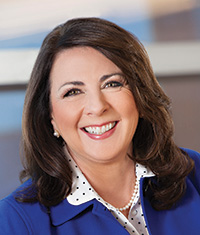
With a keen focus on innovative patient care models, Silard played a critical role in the design and construction of Stamford’s new hospital, which opened in 2016. The facility is just one of 83 hospitals or nursing homes around the world to be named a Planetree Designated Patient-Centered Hospital. The distinction recognizes health care organizations that continually advance the practice of patient-centered care through outreach, research, scholarship and innovation.
“Working with my team to create this culture of caring in a holistic, long-term way is one of the things I am most proud of,” said Silard. “We provide our patients with complementary therapies, such as massage, reiki, therapeutic touch, nutrition, music, spiritual experiences, pet therapy and more. We’re treating body, mind and spirit in our patients and in our caregivers, too. We are an organization that lives its values of integrity, compassion, responsibility, accountability and teamwork.”
Working with my team to create this culture of caring in a holistic, long-term way is one of the things I am most proud of.”
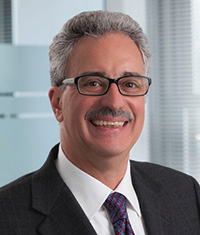
Another push to personalize care is through personalized medicine. Richard Mangano, Ph.D., ’72, who worked for over 30 years as a senior executive in the pharmaceutical industry and now serves as associate professor and director of Graduate Programs in Clinical Research at Drexel University College of Medicine, is excited about this important advancement that tailors medicine to the genetic make-up of individual patients. According to an article in P&T (Pharmacy and Therapeutics), factors such as genetics, age, nutrition, health status, environmental exposure and concurrent therapies can help guide a physician’s choice of drugs or treatment protocols that “minimize harmful side effects or ensure more successful outcomes.”
“Cancer drugs can be based on immunologic biomarkers and genetics of a specific patient,” explained Mangano. “The benefits are that patients will only be treated by a therapeutic agent if there is an indication they will respond. This immunologic approach means that more toxic chemotherapy won’t be used as much, resulting in fewer side effects for patients.”
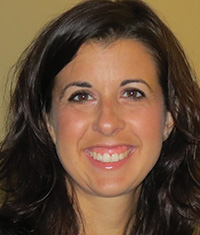
’96, physician assistant and sub-investigator in oncology clinical research with ProHEALTH
Advances in pharmacology are very personal to Mangano as he recalled the satisfaction of working on several medications that offered people a better quality of life. “I worked with hundreds of colleagues in the many stages of drug development for treatments for insomnia and depression. It was very satisfying to be part of a project that involved so much collaboration, so many stages and that culminated in a successful treatment.”
As a physician assistant and sub-investigator in oncology clinical research with ProHEALTH, Desiree Galli Grogan ’96, has had the thrill of being part of clinical trials that make medications available to patients long before they are commercially available.
She became involved with a clinical trial for a drug combination, referred to as a “smart bomb,” that targeted metastatic breast cancer. Galli Grogan had the perfect candidate and literally chased the patient down the hall to tell her about the trial. “Clinical trials can look good on paper, but we don’t know how they will turn out. This woman was willing to take a chance and 10 years later, the drug has been approved by the Food and Drug Administration (FDA), and this client is living her life fully. This trial made a significant difference in this woman’s life and I’m so glad I was able to offer her this opportunity.”
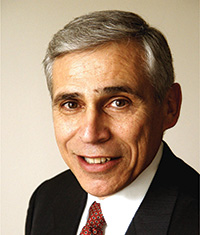
Getting to clinical trials, however, is a difficult, time consuming and costly process, with only 12% of investigational medicines ultimately gaining approval by the FDA. According to Robert J. DeLuccia ’67, ’79MBA, with almost 50 years of experience with both large pharmaceutical and smaller biopharmaceutical companies, and co-founder and managing partner of Acurx Pharmaceuticals, “As I see it, the main contributions of the industry have been the application of new scientific insights that led to the discovery, development and introduction of new drugs to treat diseases and conditions which are either life-saving or quality-of-life-changing for patients.”
According to the Centers for Disease Control and Prevention (CDC), at least two million people each year in the U.S. are infected with antibiotic-resistant bacteria and at least 23,000 people die as a result. In response to both the CDC and the World Health Organization’s call-to-action for industry and government to combat antimicrobial resistance (AMR) through new R&D, DeLuccia’ s company, Acurx Pharmaceuticals, evaluated and pursued a new class of antibiotic discovered years ago by a scientist at a leading university, but which had stalled in early preclinical development due to lack of funding. In less than a year, their lead product candidate is in its first phase of clinical trials and has received Fast Track designation from the FDA.
“Together with my co-founder, we assembled an outsourced team of experienced pharmaceutical professionals, raised funds from family, friends, and other investors, and acquired all the rights to a new drug class.” He added, “This is an example of entrepreneurship contributing to the research and development pipeline, that if ultimately successful, demonstrates how the pharmaceutical industry must nourish itself to sustain its lifespan and fill, in this case, a piece of the new antibiotic gap. Looking forward, continued advances in biopharmaceutical innovation will be critical in addressing unmet needs, improving public health, and solving future health care challenges.” Further, to ensure sustained financial resources to support continued development, Acurx intends to tap into the capital markets by taking the company public as soon as feasible.
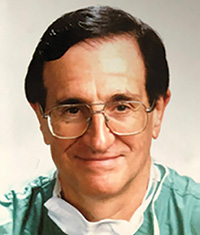
With the economics of health care at the forefront, some like John Savarese, MD, ’61, professor emeritus and former chair of the Department of Anesthesiology, New York-Presbyterian Hospital/Weill Cornell Medicine, hope for a future where economics does not always determine what new drugs come out into the market, or where patient care is not affected by consideration of revenue.
Dr. Savarese, who spent many years in the drug development industry, stated “I have witnessed incredible and dramatic changes during my career; many new drugs have been introduced, so pharmacology has been very productive. However, I can say, today if you come up with a nice new drug that looks like it is really going to benefit patient care, great, but how much is it going to cost a company to develop such a drug and if potential revenues cannot support the cost of development the company may not be interested. I can assure you there are a number of nice new drugs that never got onto the market because they cost the drug companies too much to develop. This is just one example of the economics of health care.”
On a positive note, he commented on the tremendous advances in and benefits of computer-aided treatments that didn’t exist five or 10 years ago.
Take for example radiation treatment. Dr. Savarese commented, “It used to be radiation therapy could not be applied to a single point, but now it can. Today a computer-generated radiation beam can target a tiny tumor in a critical area, like the brain, and limit the harm to surrounding tissue.
It is amazing where we are now. Just try to imagine where we will be in the next 25-50 years. It’s unimaginable, of course. We haven’t seen anything yet.”
“Health care is one of the most challenging fields to enter since it is multi-faceted and all inextricably intertwined.”
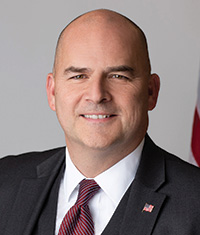
Balancing innovation and corporate responsibility have been a hallmark of Bayer Corporation for over 150 years. Raymond F. Kerins Jr. ’92, ’94MS, senior vice president and head of Communications and Government Relations, stated, “We are witnessing advances in health care like never seen before. Doctors can now test a patient’s genetic makeup to see if they are the right candidate for a specific drug, negating multiple rounds of trial and error.”
As someone who has participated in 10 FDA approvals, he is amazed at the impact companies and their products can have on people’s lives. He stated Bayer and other large corporations need to “challenge themselves to engage and educate society in the role we play in having you live healthier and better lives.” Kerins also sees the need to invest in the next generation of innovators. “I am pleased to be part of a company that sees science, technology, engineering and math (STEM) education as an important part of our future. As a company, we are committed to one million new STEM engagements with students by 2020 and five million by 2025.” As Kerins put it, “You never know where the next good idea is going to come from.”
Additional challenges during this volatile time in the industry range from the shift to values-based care and the introduction of technology to enhance performance, to meeting the growing needs of today’s consumers – including the elderly and immigrant populations.
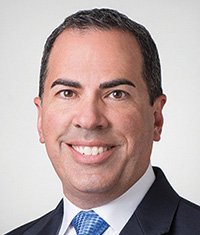
Executive vice president of Greater New York Hospital Association (GNYHA) Ventures, and president & chief executive officer, Nexera and Acurity, Chris O’Connor ’89, ’92MBA, ’94PMC, believes the seismic shift into value-based care poses changes that are challenges for health care executives, and require continuous improvement and the nimbleness to evolve. O’Connor explained, “For hospitals, the changing health care landscape has meant a transition to reimbursement models and payment penalties that reward the quality of care over the number of visits and tests ordered. The shift to value-based, patient-centered care is certainly a move in the right direction—providers are being paid to do the right thing—but it is also a significant challenge for health care professionals long accustomed to fee-for-service methods and unaccustomed to the vast data and cultural changes that are necessary to be successful (and financially viable) in this new environment.”
O’Connor commented that one of the most exciting advances he has seen, and one that defines his work at Acurity and Nexera, is a philosophy called operating at the intersection of cost, quality, and outcomes — or CQO. “Most health care professionals want to achieve this goal, but they may not truly understand how to achieve it given their institution’s culture, data and resources. Some physicians may be perceived as performing too many procedures and must learn to operate under new standards of care. Service line leaders who have become accustomed to ordering the latest technology with little or no oversight must accept new mandates that require an evidence-based motivation that is driven by how that new technology will improve patient outcomes. Health care leaders are increasingly embracing the CQO approach because it offers their workforce a framework for initiating the multidisciplinary collaboration and organization-wide acceptance that is needed to meet their value-based goals.”
“Looking forward, continued advances in biopharmaceutical innovation will be critical in addressing unmet needs, improving public health, and solving future health care challenges.”
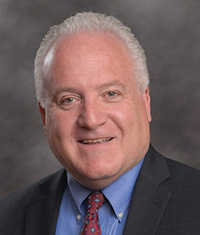
Timothy P. Leddy ’82, ’87MBA, CEO and president of Visiting Nurse Services in Westchester, which has been serving the Westchester community for 118 years, is also keenly aware of the focus on patient-centered care and cost reduction. “Hospitals are our primary referral sources for home care patients, so we are key players in helping them reduce their readmission rates,” he said. “The Affordable Care Act called for reduced payments to hospitals for excess readmissions for Medicare and Medicaid patients, so we have to respond. We need to develop value-based partnerships with other health care providers, and though we face many challenges, we must look on these changes as opportunities that ultimately lead to better care for our patients.”
Utilizing technology is just one way Visiting Nurse Services in Westchester is enhancing the patient experience. “We were the first local home care agency to provide tablets to our field staff, enabling them to record patient data during home visits, increasing efficiency and accuracy. We’ve also provided iPads to our patients, so they can monitor their own blood pressure, weight and glucose levels. That information goes immediately into our system and we can respond when necessary. This type of monitoring has substantially reduced emergency room visits and readmission to the hospital among our patients.
“…wearable sensors that measure a patient’s vital signs will soon become mainstream.”
The system is remarkably easy to use, and patients appreciate the ability to use the device and convey their health information to our clinical team. The devices have also encouraged patients to be more engaged in their health care, which generally leads to better outcomes.” Leddy sees the technology expanding and becoming even easier to use and he predicts that wearable sensors that measure a patient’s vital signs will soon become mainstream.
“We’ve worked hard to create a culture of kindness and respect, where we treat each other and our residents like family.”
Rita Mabli ’74, ’76MBA, president and CEO of United Hebrew, which just celebrated its 100th anniversary, has seen a marked increase in the overall demand for care and services. “The baby boomer generation is the nation’s largest adult population, and they are living longer than ever before. The aging population has spurred growth and expansion in the eldercare industry as a whole, as well as at United Hebrew, which has added several layers of supportive care over the years.”
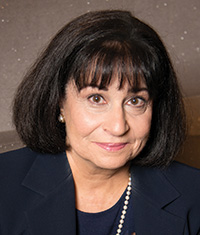
According to the December 2018 issue of The Atlantic, “When the 20th century began, life expectancy at birth in America was 47 years; now newborns are expected to live 79 years.” By the middle of the century, “American life expectancy at birth will be 88 years. By the end of the 21st century, it will be 100 years.”
This aging population poses numerous challenges to the health care industry. “As people live longer, they are more likely to develop chronic conditions that demand a higher level of health care service. And health care is expensive. We’ve had to be innovative and strategic within a complicated medical billing structure and shifting regulatory landscape. And we are always looking ahead.”
In fact, Mabli explained, “Because we’re always looking ahead, we saw the rise in Alzheimer’s disease in our region and built Westchester’s first nonprofit memory care facility dedicated to caring for those with dementia.”
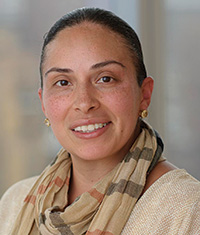
Another population in need of health care-related support is immigrant families. Julia Ramirez ’99, now the community outreach manager of Memorial Sloan Kettering’s Immigrant Health and Cancer Disparities (IHCD) Service, was just three years old when her family immigrated to the United States from El Salvador, yet she remembers playing the important role of interpreter for her family. In her current role she feels she has come full circle, interpreting for and assisting immigrant families as they navigate the healthcare system.
Ramirez began her community outreach work at NYU School of Medicine, under the mentorship of Dr. Francesca Gany, focusing on reducing
and eliminating disparities in health and cancer treatment among immigrant minorities. According to an article co-authored by Dr. Gany, “Despite an observed decrease in overall cancer death rates in the United States, immigrant minorities continue to experience disproportionately higher cancer incidence and mortality rates for many cancers.”
With the help of their community-based programs, health fairs, faith-based organizations and other community partners, Ramirez and Dr. Gany provided cancer screening, navigation and prevention information for the underserved and immigrant population, as well as connecting them with primary care physicians, and assisting them in enrolling for insurance through the Affordable Care Act.
“There is power in being an agent for change for the underserved and immigrant population.”
Ramirez followed Dr. Gany to Memorial Sloan Kettering’s IHCD Service, and for the last eight years, has been creating programming, running health fairs, providing access to services such as childcare, legal and financial advice, transportation, and psychosocial support for immigrant families. She also helps families secure access to food, through the IHCD FOOD Program, a hospital-based pantry program designed to address food insecurity among cancer patients in active treatment, to improve treatment adherence and outcomes, “Everyone needs help and should have access to basic necessities,” said Ramirez. “Cancer patients shouldn’t have to worry about where their next meal will come from.”
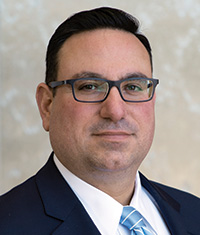
With a greater focus on the patient as a consumer, Anthony Viceroy ’90, chief executive officer of Westmed Medical Group, believes that health care organizations like Westmed are positively disrupting their own business models to create a better experience for each patient.
Viceroy believes consumers expect more, employers are looking at ways to improve employee health and productivity, and the overall cost of health care must come down through greater focus on wellness and better management of chronic conditions. He added, “You can be part of this exciting opportunity and create a sustainable brand and value proposition, or you can keep the status quo and become largely irrelevant to your stakeholders.”
At Westmed in particular, patients have responded positively to the changes taking place, including a new patient app and portal, a new user-friendly website, Tele-Health visits, and a plan to build a direct-to-employer service offering across the region.
“You can be part of this exciting opportunity and create a sustainable brand and value proposition, or you can keep the status quo and become largely irrelevant to your stakeholders.”
Similar to the sentiments shared by fellow alumni featured in this article, Viceroy is confident that there will be further technological advancements in the coming years, including artificial intelligence and machine learning, deeper clinical insights leveraging predictive analytics, and an exchange of data across different devices and systems through block chain technology. He said, “These innovations will improve not only quality of care, but also help in reducing the total cost of care.”
An article in Forbes magazine (Walker, 2016), stated that by 2030, “the very nature of disease will be further disrupted by technology,” and that the fourth industrial revolution will “ensure that humans live longer and healthier lives.” There will undoubtedly be a wave of even more exciting medical advances to surprise us in the years to come, but what will inevitably stay the same, is the need to better serve each individual patient. We are proud of all the committed Gaels making a significant impact throughout the health care community. May it inspire a new generation of scientists, physicians, and health care administrators who will continue to Fight the Good Fight for all of humankind.


Comments are closed, but trackbacks and pingbacks are open.